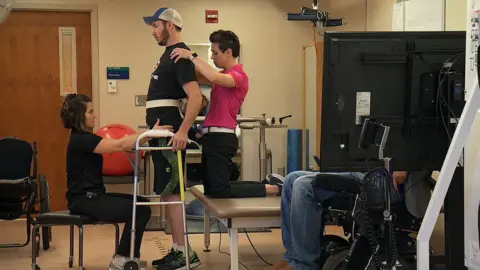Electrical implant helps paralysed people to walk again
Three patients, all paralysed from the waist down, have been able to walk again after having an electrical patch fitted to their spinal cords.
Experts say the device, which is placed below the injury, helps lost signals from the brain reach the leg muscles.
US research teams at the University of Louisville and the Mayo Clinic, report the success in Nature Medicine and the New England Journal of Medicine.
One of the recipients says her life has been transformed by the technology.
Hope after accident
Kelly Thomas, 23, from Florida, is one of two patients at the University of Louisville who has been helped by the development, which has been combined with months of intense rehabilitation therapy.
She said: "Being a participant in this study truly changed my life, as it has provided me with a hope that I didn't think was possible after my car accident.
"The first day I took steps on my own was an emotional milestone in my recovery that I'll never forget, as one minute I was walking with the trainer's assistance and while they stopped, I continued walking on my own. It's amazing what the human body can accomplish with help from research and technology."
 University of Louisville
University of LouisvilleJeff Marquis, who was injured in a mountain-biking accident, has also benefited.
The 35-year-old is now able to walk for himself with support either from a frame or from people on either side of him holding his hands.
A third patient, 29-year-old Jered Chinnock, was treated at the Mayo Clinic in collaboration with the University of California, Los Angeles.
He injured his spine in 2013 in a snowmobile accident. Since having the patch fitted he has been able to walk more than 100m with the support of a frame.
 Mayo Clinic
Mayo ClinicThe patch does not repair the damage but circumvents it by stimulating nerves lower down in the spinal cord.
This appears to allow signals from the brain to reach the target muscles so the person can voluntarily control their own movements again.
When the stimulation was switched off again the conscious movement didn't happen.
Neurosurgeon Dr Kendall Lee, who co-led the team from the Mayo Clinic in Rochester, Minnesota, said: "It's very exciting, but still very early in the research stage."
Although there are many unanswered questions, including precisely how it works and who it might help, Dr Lee said: "It gives hope to people faced with paralysis."
Other scientists have had success in the past with mending spinal damage using cells.
